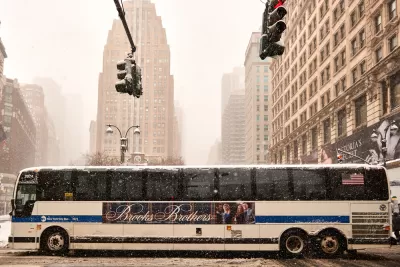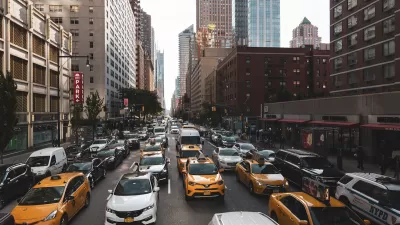A new report cites decreased ridership and dismal service despite a growing need for more and better routes.

Very few who have tried to ride a New York City bus will be surprised by the comptroller’s deeply critical report on the system. From The New York Times:
"Though New York City’s buses carry over two million passengers a day — more than the Long Island Rail Road, Metro-North, PATH and New Jersey Transit combined — they are often treated as an afterthought, even as they hemorrhage riders and strand the mostly low-income New Yorkers who depend on them, according to a report released on Monday by the city comptroller’s office."
This is not exactly news. Though expanding bus service is relatively inexpensive, it is decidedly un-glamorous, meaning that more often than not city officials end up pushing either an expensive subway project that may take a century to complete, or more recently a waterfront streetcar line.
The subway system is having its own crisis, the Times recently reported at length, but that has received more attention than the longstanding problem with buses. The comptroller’s report attributes that disparity in part to the inequity between subway and bus riders.
“[W]hen the buses run late, or barely run at all, those affected are often from low-income, minority or immigrant communities, the report says. The average personal income of bus commuters is $28,455, compared with $40,000 for subway commuters, the comptroller’s report says. More than half of bus commuters are foreign-born, and only 25 percent are white.”
Despite the fact that ridership is down, the need for city bus service is up, as the number of people and jobs in boroughs other than Manhattan have grown dramatically in recent years.
Ambitious plans for the bus lines historically fail to take priority, so even though mayor’s administration points out that it has “committed $270 million to Select Bus Service and had announced plans last month to add 21 of the express routes over the next decade,” the question that remains is whether or not the city will deliver.
FULL STORY: Bus Service Is in Crisis, City Comptroller’s Report Says

Maui's Vacation Rental Debate Turns Ugly
Verbal attacks, misinformation campaigns and fistfights plague a high-stakes debate to convert thousands of vacation rentals into long-term housing.

Planetizen Federal Action Tracker
A weekly monitor of how Trump’s orders and actions are impacting planners and planning in America.

In Urban Planning, AI Prompting Could be the New Design Thinking
Creativity has long been key to great urban design. What if we see AI as our new creative partner?

Portland Raises Parking Fees to Pay for Street Maintenance
The city is struggling to bridge a massive budget gap at the Bureau of Transportation, which largely depleted its reserves during the Civd-19 pandemic.

Spokane Mayor Introduces Housing Reforms Package
Mayor Lisa Brown’s proposals include deferring or waiving some development fees to encourage more affordable housing development.

Houston Mayor Kills Another Bike Lane
The mayor rejected a proposed bike lane in the Montrose district in keeping with his pledge to maintain car lanes.
Urban Design for Planners 1: Software Tools
This six-course series explores essential urban design concepts using open source software and equips planners with the tools they need to participate fully in the urban design process.
Planning for Universal Design
Learn the tools for implementing Universal Design in planning regulations.
Gallatin County Department of Planning & Community Development
Heyer Gruel & Associates PA
JM Goldson LLC
City of Camden Redevelopment Agency
City of Astoria
Transportation Research & Education Center (TREC) at Portland State University
Jefferson Parish Government
Camden Redevelopment Agency
City of Claremont




























